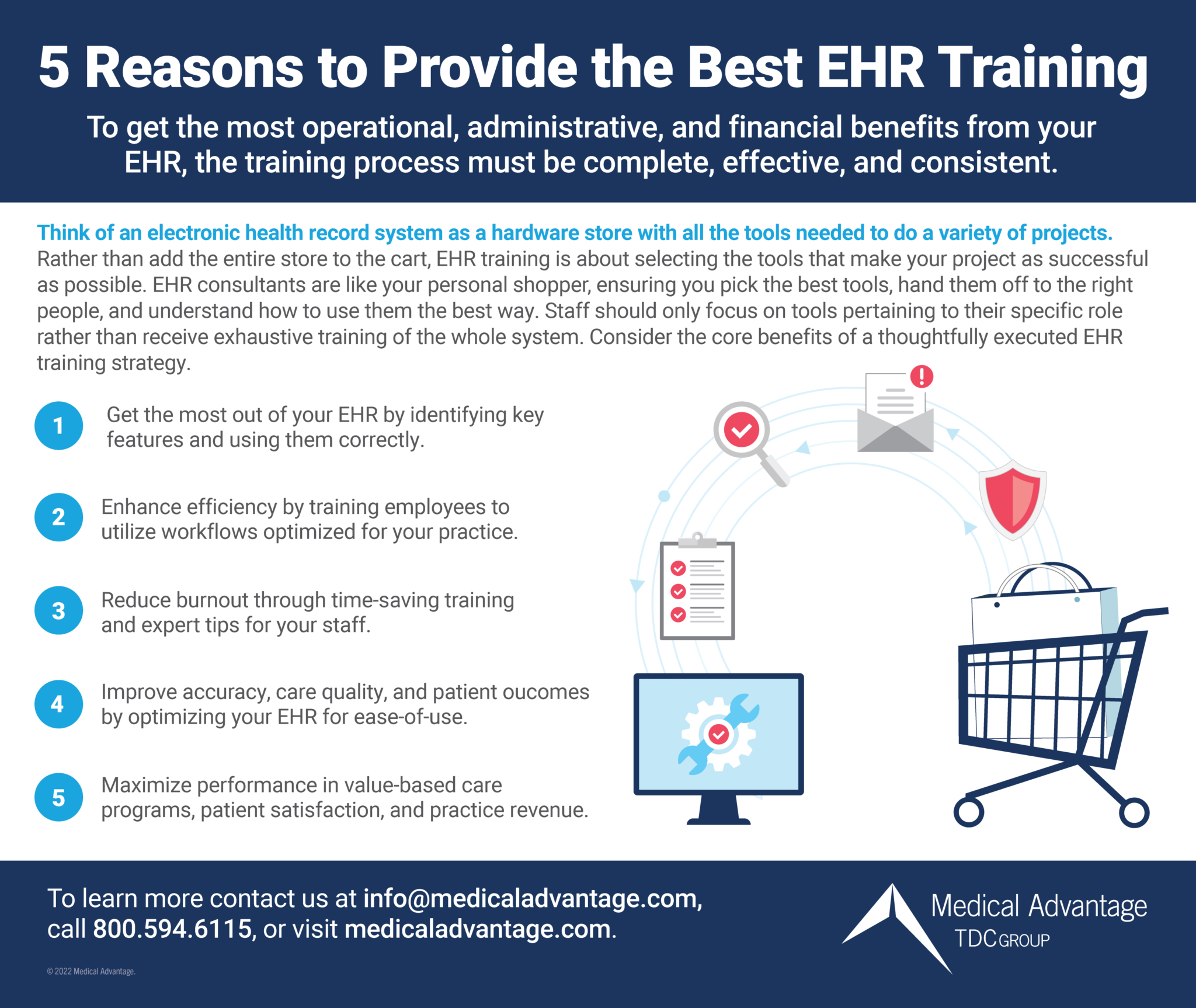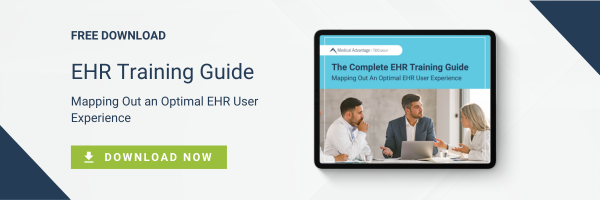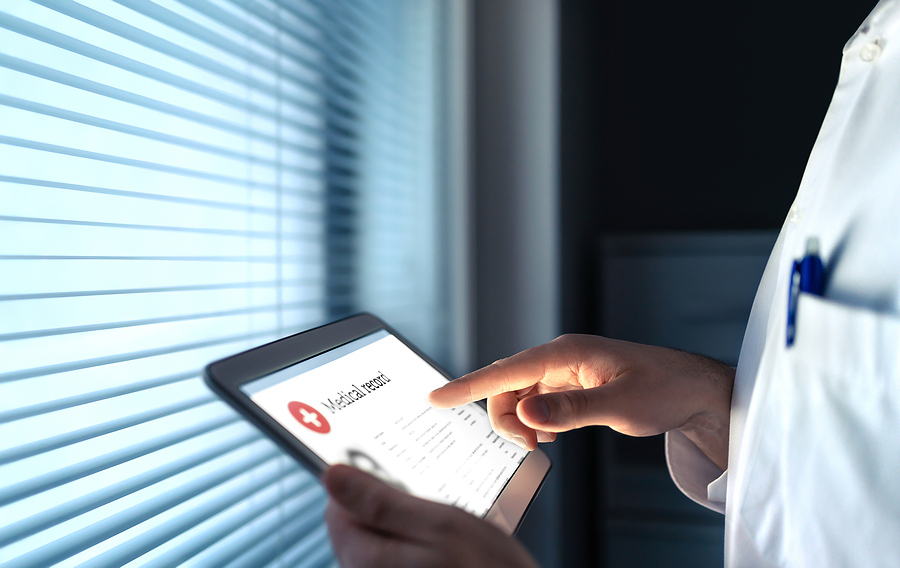Simply put, getting the most out of your electronic health records system (EHR) hinges on training your staff and proper EHR configuration. Extracting the value of your new EHR’s features begins with EHR implementation that considers what features are available, who on your team would benefit from using them, and how to best utilize them. User EHR proficiency plays a pivotal role positive in care outcomes as it enables the sharing of information among a patient’s care team.
Why Is Training Your Staff for EHR Implementation Important?
While it would be nice for an EHR to be plug-and-play right out of the box, the reality is that the software is not meant to work the same for every practice, nor will everyone on staff be using the same set of functions. By taking the time to ensure that everyone receives training appropriate to the role and according to practice goals, you can reap the benefits and avoid the pitfalls of your EHR.
Preparing Your EHR Training Plan
The transition from paper-based documentation to an electronic healthcare record system or implementing a new EHR may seem daunting, but with the right plan and preparation, the process can be streamlined for maximum efficiency and successful utilization. One of the critical pieces of this transition is creating an EHR training plan, including the following steps.
1. Define goals and objectives — The success of your EHR training plan lies in defining clear goals and objectives. Determine what you want to achieve with your EHR system and how staff training can help you achieve those goals. Common goals include increased efficiency through automation, patient engagement tools, improved productivity, or more accurate documentation. Make the goals and objectives specific and measurable to track progress while using benchmarks to define targets.
2. Establish timeline and training duration — EHR training duration varies based on your organization’s size, complexity of your EHR system, and the training method used. Outlining the training timeline is critical to coordinate participation and minimize disruption to patient care while reducing downtime/closure. Determine which training method works best for your staff, whether it is online training, in-person and hands-on training, or a combination of both. Set milestones and deadlines along the way to ensure progress by defining expectations. The training schedule may be affected by other key dates in the timeline, such as when the EHR system goes live.
3. Assess your staff — Assessing your staff’s skills and knowledge base is essential to determine an effective and efficient training plan. Identify which employees will use the EHR system, assess their current skills, and identify areas where they may need additional training. Consider their experience with technology and whether they will need a computer skills refresher. When there are different levels of proficiency among staff, it may work best to group them accordingly into different training tracks.
4. Leverage external resources — For a more efficient and thorough training plan, engage with an experienced EHR consultant. Most EHR vendors provide training materials, training courses, manuals, and practice labs, but nothing can take the place of a customized training program.
5. Assess and evaluate progress — Assess the staff’s progress by conducting pre- and post-training competency assessments and regularly monitor progress and performance metrics to ensure staff are retaining the training and using the EHR effectively. Regular evaluations will help determine whether additional training is necessary to achieve the desired outcomes.
Process-based EHR training
Mapping is an effective tool for any tactical strategy to support training success. Process-based EHR training is about determining the most sensible workflows for each user of the EHR while also coordinating effectively with stakeholders outside the practice.
Who does what task and how it will be executed should be clearly defined for each team member. What needs to be accomplished from A to Z, and are there more steps than necessary? Bottlenecks and workflow inefficiencies should be tackled from an angle of process-based training solutions.
Role-Based EHR Training
Personalized training according to each role within the organization is a core best practice for EHR training. In other words, the training modules for each group (clinicians, support staff, back office, IT, etc.) should be tailored to each role.
How many times have you sat through hours of training asking, “Why do I need to know this?” Chances are that a trainee is tuning out much of what is being presented when the material is not applicable to their role.
Narrowing the training topics down allows each staff member to focus on becoming proficient in EHR use according to the role they serve. Having a one-size-fits-all approach is generally not the best use of time as many users end up trying to learn functions they will never need. Keep in mind that you can always cross-train staff as responsibilities change.
Identify EHR Savvy Superusers
Your team may already have someone operating as a superuser, or you may have someone in mind. An EHR superuser is considered the go-to expert in the practice and may be called upon to assist with teaching other staff members. Compared to other EHR users, this role will require more extensive training in the EHR.
When unsure of who would be the best superuser for your practice, consider assessing your staff members to identify candidates for this role. Your electronic medical records (EMR) superuser may be an ideal candidate for cross training. Factors at play are:
- Hard skill assessment – Who has extensive experience with healthcare software, or EHRs? Who has the most computer literacy, or an information technology background?
- Soft skills assessment – Which staff member can troubleshoot, communicate solutions, learn quickly, keep a positive mindset, and effectively coach others in EHR use?
- Tenure – Has this individual been part of the practice long enough to understand the ins and outs of operations, and have they established rapport within the team?
- Bandwidth – Is the team member already saddled with so many responsibilities that it would be difficult to pivot to superuser when needed? For example, a physician may have experience with many EHRs, and be an excellent teacher, but they are too busy with patients to be interrupted by EHR trouble tickets.
Because superusers possess a highly marketable skill set, it is wise to compensate them well according to these new responsibilities. If feasible, having one or more tech-savvy additional superusers on staff can serve as back-up in the absence of another. Having more than one superuser can also balance responsibilities.
Training Tip: When scouting for potential superusers, consider evaluating everyone for computer proficiency to identify skill gaps. Awareness of where certain staff members may have challenges using the EHR may uncover remedial training opportunities in preparation for full EHR training.
Create an EHR Training Team
Successful EHR training is about having the right people in the right places within a workflow. Moreover, the training team should have representation from every care team department – administrative staff, clinical, technical, etc. Core roles in training staff for EHR implementation are:
- Implementation superuser – If you have multiple superusers on your team, one of them should be assigned to direct the implementation process, including the initial training. This role involves problem resolution, mapping workflows, developing standard operating procedures, or customization of the database. This role is crucial for success as they support the many aspects of implementation.
- Physician or Chief Medical Information Officer (CMIO): – One doctor is delegated as the intermediary between technical staff and the front-line users and may also raise concerns about care delivery aspects that would help steer training.
- Department heads – For larger organizations, each department should have a lead to serve as advocate for their respective team. They can communicate what their team needs and offer recommendations for step-by-step instructions.
- Project Manager – Aside from the usual project manager duties, such as keeping everything on schedule and on target, this role also serves as liaison between the vendor and the practice staff to ensure a smooth transition.
- Practice Manager – The world does not stop when you need to train staff on your EHR, and neither will practice operations. Managment will need to plan ahead for staff coverage so that patient care continues while some members are in training. Do you need to hire temporary staff or call upon PRN staff to fill in?
- EHR Consultant – Experienced consultants lend a hand for training development including go-live events, carry out a “train the trainer” program, and can fulfill some superuser duties as needed.
How many people make up that team depends on your unique circumstances and the size of your organization. Additional roles apart from this list may need to be added.
While EHR consultants are optional, their expertise is invaluable for planning training and implementation. They understand precisely how to provide staff and physician training to ensure the software provides optimal interoperability for both internal and external stakeholders. It is worth contacting EHR consulting services with your questions to help decide if you need additional help for successful implementation.
While the completion of go-live might seem like it is the end, keep in mind that EHR training does not stop there. Whenever inevitable organizational changes occur such as new hires, promotions, introduction of new features, software upgrades, restructuring these all call for training. These opportunities give you a chance to refine your training so that it keeps improving over time.
Scheduling Post-Training Feedback Sessions
EHR post-training feedback sessions can help identify setbacks and snags and keep staff up to date with new features. Consider the following when planning EHR post-training feedback sessions:
- Identify areas of opportunity: EHR post-training feedback sessions allow you to identify weak areas in your training program. During the training session, staff may not ask questions or admit their struggles. Feedback sessions allow them to share their thoughts anonymously. You can use the feedback to determine areas that may need additional resources or retraining.
- Improve user adoption: Staff who are not confident in using the EHR system may avoid certain tasks, resulting in suboptimal care. By assessing staff and identifying areas where they need more assistance, you can address their training needs, which will lead to better user adoption.
- Gather data for process improvement: Feedback sessions can also provide valuable data that can be used for process improvement. You can identify areas where workflows need to be modified or create additional training resources that cover common questions or concerns.
- Keep staff up to date with new features: EHR systems are constantly updated with new features and capabilities. This practice ensures staff remain up to date with the new EHR system features and understand how and when to use them.
- Maximize the impact of feedback: For EHR post-training feedback sessions to be impactful, you need to maximize the insights and data you gather. Ensure staff knows that their feedback is valuable and that it will be used to improve the EHR system and training program. Use this feedback to create actionable items that can be implemented in a timely manner.

Key Benefits of Effective EHR Training
Knowing all you stand to gain should motivate and incentivize your practice to explore improvement opportunities for staff EHR implementation training. EHRs are designed to support the demands of quality healthcare, but with so many features and options to sort through, it is wise to take the time to ensure that the whole staff becomes proficient in optimal EHR usage.
1. Get the Most Benefit
An EHR is like a hardware store. Inside, it has every tool you need to do the job, but you will not be adding everything to your cart, and you need to understand how the materials work together before you secure supplies and start the work.
Personalized EHR training is like having your own personal shopping assistant handing you the best tools and explaining how each of them works for your tasks. Instead of using what you think you need, you now have access to an expert contractor leading you down the aisle to a more suitable tool for the task, one you may not have been aware of otherwise.
By using your EHR to its full potential with a more cohesive utilization of features, the software becomes your ally in efficient operations.
2. Promote Productivity with Efficient Workflows
The aim of having sophisticated software is to reduce manual entry, mitigate user error, and facilitate integration. If, on a frequent basis, your staff experiences redundant tasks, misaligned communication, or processes that seem needlessly tedious, it is time to explore if your EHR could be better utilized.
Ideally, each staff member should be using the most appropriate features in a manner that best supports the workflow, and minimizes redundancy, all of which promotes efficiency and productivity. In the end, time spent on EHR tasks should be reduced, and workflows should be streamlined.
3. Reduce Burnout
Many dread EHR tasks, but it does not have to be this way. Healthcare professionals entered the medical field to help people but end up spending a substantial amount of time fighting with technology instead. This impacts providers more than one might expect.
Studies have found that the lack of customization and EHR training is the root cause of much physician dissatisfaction and that the EHR training itself predetermines work satisfaction. Those who received fewer than four hours of training reported a frustrating experience with their EHR usage, which can in turn hinder quality delivery of care and result in staff turnover.
Talent acquisition and retention have been a challenge for both small and larger practices in recent years, so making sure they get the best EHR training can mitigate healthcare professional attrition. With well-attuned training, the practice team can be in control of the EHR rather than having the EHR chip away at time and patience.
Two different practices could have the same EHR but have entirely different experiences with it based on what training each team receives. How a staff responds to and interacts with the EHR truly does hinge on the rigor of the training. Personalization and effective training make all the difference. Otherwise, valuable, and time-saving features may go unnoticed and underutilized.
4. Improve Accuracy and Care Quality
Without proper training or proper use of an EHR, patient data can be entered incorrectly: the information is wrong, omitted, or mixed up with another patient. Now imagine how all others involved in the care of this patient will now have wrong or incomplete data on hand. This, of course, impairs care quality and potentially leads to serious missteps in patient care depending on the errors made.
For everyone involved in making those key decisions that produce the best patient outcomes, there must be training that establishes standards of use and best practices. This will set expectations of usage that avert potential errors and cultivate exceptional care quality.
Summary: Creating an Effective EHR Training Plan
Training your staff for EHR implementation lays the groundwork for long-term rewards such as a more reliable revenue cycle management process, and better performance on quality measures in value-based care. A medical practice team that is adept at efficient daily use of software tools can spend less time in front of a screen and more time attending to patients. To get the most operational, administrative, and financial support from your EHR, the training must be an ongoing process that is complete, results-oriented, and consistent.
Get the Training Support You Need with Medical Advantage
The ultimate medical practice goal is to provide the best patient care and to maximize revenue, and the quality of EHR training is crucial to achieve these aims.
Effective EHR implementation training improves many areas of healthcare organizations, including population health, value-based care, patient outcomes, healthcare data analytics, and care coordination. Accountable care organizations, hospitals, and clinics would all benefit from an EHR training fine-tuned by seasoned EHR specialists.
Our consultants bring to the table years of experience in the healthcare technology space. Going into your EHR training program confidently will give others the same reassurance and set a solid foundation for years to come. Reach out today with your EHR training questions! We are here to help.






